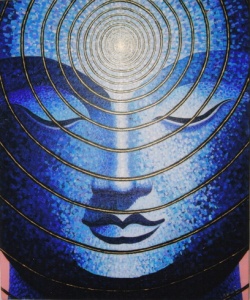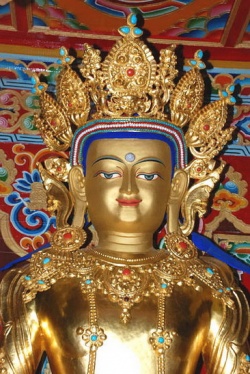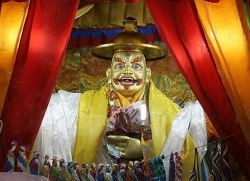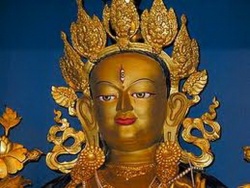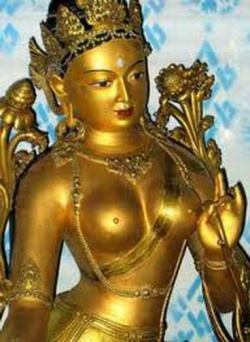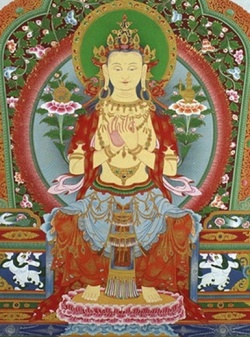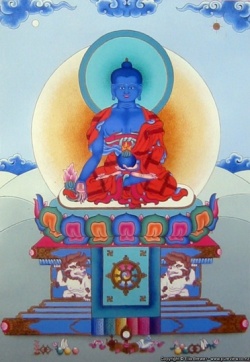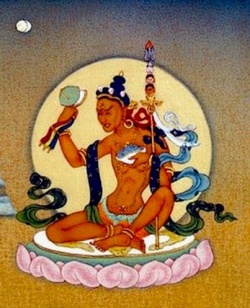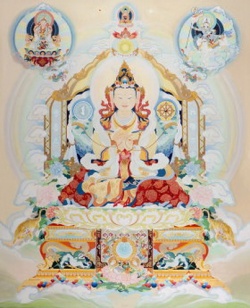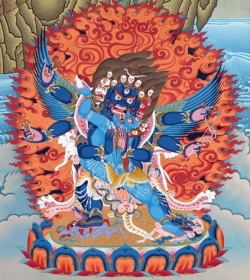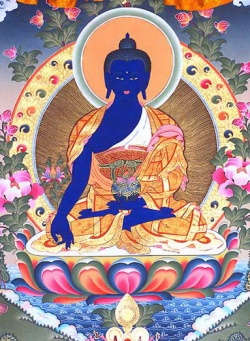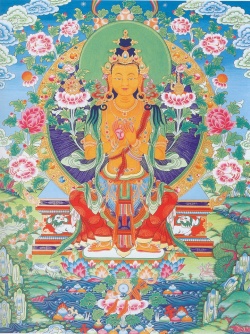On local and mountain deities in Bhutan by Françoise Pommaret
Introduction : Methodological problems and classifications
In Bhutan, one hears of btsan, dge bsnyen, yul lha, "nep" (gnas pa), gter bdag and gzhi bdag. These deities, which play an important role in the lives of the Bhutanese, live in sacred places, often mountains and have to be propitiated by the people at regular intervals. However, it was never particularly clear to me what these names referred to exactly, and how these deities related to one another. It would be beyond the scope of this paper, as well as a preposterous undertaking, to attempt to review the subject of mountain and local deities a subject that has already been examined in at least two major works.i In this paper, I would simply like to present some preliminary remarks on Bhutanese material related to mountain and local deities, and at the same time try to place them in the more general context of methodology and classification.
Much has been written on local and mountain deities in the Tibetan and Tibeto- Burman worldii and Nebesky-Wojkowitz, in his impressive work, has classified many of them. However, his study reveals that, as perceived by us in the West, categories overlap and definitions can sometimes be quite vague. T. Kleeman faces the same problem when speaking about mountain deities in China in the 3rd century B.C.: "At this early stage there seems to be no consistent differentiation between mountain gods (shanshen), mountain spirits (shanling), and mountain ghosts (shangui)."iii Before Nebesky, G. Tucci had already made "attempts at classifying early gods, including local and mountain gods."iv He used various Tibetan sources but his conclusion is, unfortunately, still valid today: "(...) It appears that these classifications do not cover at all the great variety of spirits, ghosts, demons, gods in which Tibetans believed. The character of these beings was in many cases so vague that it was very difficult to establish a demarcation between them. (...)
Even the place where they were supposed to dwell is not enough to establish a clear distinction between the various classes of gods: for lack of individuality these divine groups tended to blend together."v 2 The whole issue of definitions is all the more complex today, as recent extensive fieldwork in the Himalayas has shown significant variations from region to region among deities refered to by the same generic term. Moreover, in real life, the interpretation of a deity can vary greatly from that of the literary context. However, the written sources themselves, as Nebesky demonstrated, do not show a homogeneous tradition. The impression one gets from Nebesky's study and work in the field is that the different classifications made by the Buddhist and Bon po schools might have been an attempt to give some order and theological justification to a large range of non-Buddhist deities which, originally, might not have been very well differentiated or may have lost their differentiation by the people.
Lastly, there may be a difference in the use of terminology between Buddhist texts and popular usage. Could we say that we are confronted with a set of deities that are amongst the most common in the Tibetan world, but whose exact definition and classification still seem to elude us? This could lead to questioning our need for classification classification that might not have any relevance in the Tibetan popular context where deities exist without anybody having the urge to understand, in an intellectual way, how they relate to each other. One can note, however, that Buddhist and Bon po scholars must have faced the same question, as they themselves tried try to classify them.
This is certainly another occurrence of the gap that exists in the Tibetan world between scholarly and popular traditions.vi Added to our lack of knowledge and our Western need for an organised pantheon, the superposition or mixing of these two traditions render the issue of definition all the more complex. G. Samuel writes: "For the Tibetans, the universe in which they live is seen as capable of multiple interpretations, which are not necessarily exclusive. Rationality is not, as it tends to be in contemporary Western society, the single dominant mode of legitimate discourse."vii It seems that all these deities are also referred to, at one point or another, by the title dam can, "those who are bound by an oath", because they are deities that have been subjugated and sworn to protect the Buddhist doctrine.
In Bhutan, mountain and local deities are also sometimes referred to as chos skyong (Skt Dharmapala) "Protectors of the religion", or srung ma "guardian-deities". These generic terms are themselves ambiguous as they are 3 sometimes applied to the 'Jig rten pa'i srung ma, "the Protectors of the world" category which interests us today as well as to some "deities who have passed beyond the six spheres of existence", the 'Jig rten las 'das pa. Once more, because of the lack of proper fieldwork and methodology in this domain, in Tibet, it is difficult to be very precise or assertive. For example, in Bhutan, it seems to me that the term chos skyong is much more popular than srung ma, the latter being reserved for a higher category of deities that protect an important Lama or a particular religious school.viii Another difficult term is dgra lha, "enemy god", which can be applied to deities belonging to both categories, the 'Jig rten pa'i srung ma and the 'Jig rten las 'das pa'i srung ma. However, as Nebesky has pointed out,ix if "the title dgra lha 'enemy-god', is usually given to those deities who are believed to be especially capable of protecting their worshippers against enemies, and to help them to increase their property", the term dgra lha is also "the name of one particular, personal protective deity. The seat of the personal dgra lha, whom each man is supposed to have, is the right shoulder (...).
The personal dgra lha, as well as the divinities belonging to the various dgra lha groups, are believed to protect the lives of their worshippers and to help them overcome obstacles and defeat their enemies." As for the personal dgra lha and the yul lha, they belong to the category of 'Go ba'i lha lnga, "the Five Head Gods", which Nebesky considers as "a group of five ancient Tibetan deities".x A. Macdonald also deals with these deities and says that there was an assimilation between 'go ba'i lha and sku bla, the latter being sometimes assimilated with the gnyan, another category of deities: "Sur ce point la tradition tardive concorde donc avec la tradition ancienne, car on sait que les gnyan forment une catégorie de dieux du site et en particulier de dieux-montagnes, notamment quand ils sont également définis comme sku lha."xi And according to Tucci, "it is evident that the btsan can hardly be distinguished from the gnyan."xii It seems to me that we have advanced very little in our understanding of the relations between these categories of deities since all these comments were written.
As mountain-deities, the gnyan do not seem to be very present in the popular 4 tradition today, but this point has to be confirmed by further research.xiii It is the same phenomenon with the sku lha, although at least one mountain name bears witness of these ancient gods: the sKu lha mkha'/gangs ri, which stands in Tibet, just north of the Bhutanese region of Bumthang. If we follow the written tradition, the btsan, the yul lha ,"local god", and a number of "mountain deities" belong to the numerous 'Jig rten pa'i srung ma. Within this category, the btsan belong to the lha srin sde brgyad, "the Eight Classes of Gods and Demons", which are said to have been subdued by Padmasambhava.xiv In his attempt to define a btsan, Tucci develops the idea of linking a btsan to a particular place that he would rule:xv "They appear in fact as tribal gods.
They were deities located in a particular place, generally a mountain, in some cases a whole country, over which they were considered to preside. The btsan was the all powerful spirit under whose sway other demons and entities were supposed to be. He therefore was the patron of the ethnical groups living in that very country: he was a ruler, the spiritual ruler over a district and its inhabitants." Thus far, the position of the gzhi bdag, "master of the place", who can be a dgra lha, vis-à-vis the yul lha, is quite blurry.
It seems to me that in Bhutan, it often coincides with the yul lha. S.G. Karmay has remarked that, in Eastern Tibet, gzhi bdag and yul lha are often equivalent.xvi As for the sa bdag, "master of the soil", it is associated with a specific spot and not with a whole territory. As the Tibetans envisage the world, the yul lha and the gzhi bdag pertain to a horizontal notion of space and to a precise territory, while the btsan belongs to a vertical conception of a world divided into different domains. This might help shed some light on the btsan/yul lha equivalence often noted, but my observations in the field have not been very conclusive. Iconography is not of much help in this research.
However, a detailed comparative study might prove useful, as these deities have a very similar iconography and it is sometimes difficult to distinguish among them. They often have a warrior-like aspect, wearing armour and helmet and riding on a horse, or clad in a robe and heavy boots. It is interesting to note that a specific term that would mean "mountain deity" exists 5 neither in Bhutan, nor, to my knowledge, in the rest of the Tibetan world. The term lha ri, which means "divine mountain", seems to be found only as a component of the name of a mountain such as Jo mo lHa ri or lHa ri gyang do/mtho. This brings us back to A. Macdonald's theory on the pre-Buddhist religion, in which the deities were the mountains themselves, and to the interesting alternative of which I was reminded by A.M. Blondeau bla ri "soul mountain"/ lha ri "divine mountain".
Are the mountains the deities themselves, or just their abodes? This is the eternal question, on which even the people living in a given region are unclear, as P.A. Berglie notes: "When we turn to the spirit-mediums' conceptions of Mount Targo and Lake Dangra and their gods, let us first note a basic ambiguity. On one hand Targo and Dangra were conceived as supernatural beings in themselves, as a sacred mountain and a sacred lake married to each other (...). On the other hand, both the mountain and the lakes are thought to be inhabited by several gods and goddesses important to the functions of the dpa' bo." xvii To try to solve some of these problems,
I would like to suggest an attempt at making a typology. This might ultimately be a futile exercise, but it might be worth trying to sort out, according to region, the terminology as well as the identity and role of these deities. This typology could be in the form of a matrix with recurrent traits, and each time a researcher encounters a deity, he/she could add it to the matrix and note the relevant criteria. I propose the following traits, but this list is not exhaustive. Moreover, instead of creating a single category called "name", I propose that all possible names and titles given to the deities be listed so that we can see when they overlap: btsan, mountain-deity (?), local deity (yul lha, gnas pa), gzhi bdag, dgra lha, chos skyong, gnod sbyin, pho lha, other), territory, intercessor, festival, link to traditional ruler, mountain abode, female-deity consort, etc. This typology would not be an end in itself, but rather a tool, enabling researchers to work on a sound and common base, and perhaps, in turn, try to tame these elusive deities.
Bhutanese material
The following notes on Bhutan must be considered as a preliminary survey based on limited fieldwork and casual conversations. Although it is necessary to be cautious and as 6 precise as possible when dealing with the terminology and what the terms really refer to, it is sometimes difficult to be accurate. Respect for mountains is very much alive in Bhutan. A mountain that is considered the seat of a deity is forbidden to mountaineers. After the Department of Tourism allowed two expeditions on the Ji chu (sp.= Jo bo ?) Brag skyes in the upper Paro (sPa gro) valley in 1983, the yak herders who live in this region complained that the deity was angered and had caused hailstorms and disease among the cattle. The mountain is now out of bounds for mountaineers. Fumigations are offered to mountains and a yearly festival is held in their honour.
The names of these festivals vary according to the region but the terms gsol kha or mchod pa are widespread. In Bhutan, a btsan is often, but not systematically, a yul lha/gzhi bdag. A yul lha may or may not be a mountain-deity and, to date and to my knowledge, there does not seem to be a specific term in Bhutan for "mountain-deity". The term yul lha is sometimes replaced with "Nep", gnas pa or even gnas bdag, especially if it is a minor deity. In most regions of Bhutan, the btsan 's name is preceded by the term of address "Ap". This means, in a village context, "Father" or "Mr.". The French term "Le père . . .", still used in the countryside, would be a good equivalent of this "Ap".
It implies a certain familiarity, the fact being that the person is from the same place, while being a little respectful. But it also probably connotes an idea of kinship with the deity and directly links it to the people. An attempt to classify local and mountain deities shows that at least four categories may exist in Bhutan. Each category is illustrated by examples: 1 btsan that might not be associated with a particular mountain in Bhutan but are said to be mountain deities in other Tibetan areas: dGe bsnyen Jag pa me len ; 2 btsan/ yul lha that are associated with a mountain: Jo bo (rDo rje) Brag skyes and Khyung bdud and Zo ra rva skyes; 3 Mountain deities that are not btsan but are yul lha: bKra shis tshe ring and Jo mo sKu mkhar; (these first three categories have all been integrated into Buddhism) 4 Mountain deities that are not btsan, and which have not been incorporated into 7 Buddhism: the phyva. This classification represents to date, the state of research, and may be modified in the future following further investigations.
1 dGe bsnyen Jag pa me len
An example of a btsan that does not seem to be associated with a mountain is the dGe bsnyen Jag pa me len, the term dGe bsnyen being a title, Upasaka, and a category at the same time. Nebesky mentions a list of twenty-one dGe bsnyen that are mountain deities.xviii The dGe bsnyen Jag pa me len is said to have been subdued by Kun dgag ge, the 7th hierarch of the 'Brug pa school (1314-1347), when he visited the region of Thimphu and turned dGe bsnyen Jag pa me len into the protector Srog bdag gShan pa dmar po.xix Nebeskyxx notes that dGe bsnyen Jag pa me len acts as the dgra lha of Bhutan and that he is "an emanation of rTa mgrin. Padmasambhava himself is supposed to have been his subduer." His seat is the monastery of bDe chen phug, which was founded in the 13th century by Dam pa, the son of Pha jo 'Brug sgom zhig po who introduced the 'Brug pa school to Bhutan.
He is said to be the partner of sMan mo, a female water-deity residing at sPang ri zam pa, another monastery about 5 kms from bDe chen phug. sPang ri zam pa was founded by Ngag dbang chos rgyal, the 14th hierarch of the 'Brug pa (1464-1540), and was the first residence in Thimphu of his great-grand-son, the Zhabs drung Ngag dbang rnam rgyal (1594-1651) when he arrived in Bhutan from Ralung in 1616. Both temples are thus strongly connected to the 'Brug pa school, but bDe chen phug, because it houses dGe bsnyen Jag pa me len, is considered the seat of the guardian deities of the 'Brug pa school in Bhutan.
He is, with Dom tshangs, one of the two guardian deities that are considered as the yul lha, or gnas pa, of the Thimphu valley. His territory extends from the upper end of the valley to Kawajangsa (rKang wang byang sa), beyond the Thimphu dzong. From there, Dom tshangs, whose seat is lCang sgang kha temple which dominates what is today Thimphu town, takes over and rules as far as Simtokha (Srin mo rdo kha, or Sems thogs kha, in the new Dzongkha spelling) dzong at the lower end of the Thimphu valley.
At the time of the Zhabs drung, these two territories rKang wang (or Ka wang, in 8 modern Dzongkha spelling) and lCang belonged to territories that were called the "Eight Great Hosts of Wang" (Wang tsho chen brgyad). From these eight "villages" of Thimphu and Punakha came the men who were the elite, favoured by the Zhabs drung, and who formed his militia.xxi Today, according to their place of birth, people of the Thimphu valley must go once a year and worship either dGe bsnyen Jag pa me len or Dom tshangs; failing that, the wrath of the deities is likely to strike them. Their worship takes the form of a gser skyems and, in fact, in its form today, the text of the gser skyems called dGe bsnyen chen po Jag pa me len gyi gser skyems also includes the ritual for Dom Tshangs: lCang sgang kha'i gnas bdag Dom tshangs pa'i gser skyems. dGe bsnyen Jag pa me len is thus very clearly connected not only to a territory and the people living in it, but also, as the protective deity of the 'Brug pa, to the ancient Power linked to this territory.
It should, however, be noted that Nebeskyxxii mentions a mountain-deity bDud btsan dPa' bo hum ri, also referred to by the title dGe bsnyen chen po, and who has his seat on the dPa' bo hum ri mountain in Sikkim. The term dGe bsnyen, therefore, has to be checked carefully, because often the people of a valley refer to the local deity only by this title. They obviously do not see the need to use, or do not know, the full name of their deity, just calling him dGe bsnyen. dGe bsnyen is sometimes called Ap dGe bsnyen.
2 Jo bo (rDo rje) Brag skyes, Khyung bdud and Zo ra rva skyes
Jo bo (rDo rje) Brag skyes is a powerful btsan and yul lha that rules part of the Paro valley. As is the case with dGe bsnyen Jag pa me len and Dom Tshangs in Thimphu, people must come to Paro once a year and offer a gSer skyems to the mountain deity if they were born in the territory under this deity's jurisdiction.
Another mountain deity that seems to be a btsan and a yul lha is Khyung bdud. Called "Ap Chhundu" in western Bhutan, he is revered and loved by the people of the Had/Haa valley. Khyung bdud is mentioned by Nebesky,xxiii who uses the spelling "Khyung dung", and who includes him in the chapter on local Protective deities but considers him as a mountain-deity: "Close to the point where the borders of Sikkim, Bhutan, and Tibet meet lies 9 a mountain called Khyung dung gangs, which is supposed to be the residence of a chos skyong known by his full name as the Pho lha chen po, the Ma sangs Khyung dung. As already indicated by this appellation, he is believed to be a 'god of the males' (pho lha), and he is therefore especially venerated by those who desire to obtain great physical strength. He acts, too, as one of the main Protective deities of the dpa' bo and bsnyen jo mo the sorcerers and sorceresses of the unorganized Bon in the Sikkim-Bhutan-Chumbi area who are said to address him in the first place when invoking their various supernatural helpers." I will come back to this last point later but I would like now to examine briefly the role of Khyung bdud in the Haa valley and the beliefs attached to him.
Although Nebesky says that Khyung dung is the deity attached to an eponymous mountain, the people of Haa associate him with the gNas ri phun gsum or Mi ri phun gsum, a mountain with three peaks which dominates the valley. Local stories related to Haa and Khyung bdud reveal some aspects of the conversion of the valley to Buddhism. While they are the seat of Khyung bdud, these three peaks are also now believed to be the abode of the Rigs gsum mgon po, Avalokitesvara, Manjusri and Vajrapani, and the two most sacred temples of the valley the Lha khang dkar po and the Lha khang nag po were built at their foot. Although there are no ancient historical records, Haa people believe that these two temples were built by the King Srong btsan sgam po at the same time as Paro sKyer chu and Bumthang Byams pa'i lha khang, which are included in the well-known scheme of the subjugation of the demoness.xxiv This story has been written down by dGe shes Brag phug dGe 'dun rin chen, who was born in Haa and is now the 69th rJe mkhan po of Bhutan, in his book, the Lho'i chos 'byung gsar pa (folio 64a-b).
He relates how Srong btsan sgam po emanated in the form of two pigeons, one white and one black, which he sent to Haa to build the two temples. One origin for the name of this valley is attributed to some people who suddenly (had kyis) left the mountain associated with Khyung bdud and came down to build these temples in one day. The whole valley was named Had, "Sudden".xxv The great contemporary historian Lopen Pemala (Slob dpon Pad ma Tshe dbang)xxvi gives two other versions of the origin of the name Had/Haa. One says that the name of the 10 valley came from the exclamation expressed by people when they saw the imposing mountain. The other attributes a role to Padmasambhava. Guru Rinpoche is said to have subdued Khyung bdud and turned the valley into a "hidden country", a sbas yul, by uttering the mantra "Haa". Khyung bdud became a protector, a function which is illustrated by the following story reported by dGe shes Brag phug: The sculptor who was making a statue of Amitayus for the Lha khang dkar po could not craft a head that would match the body.
He was in despair, when a man appeared carrying a bamboo basket that contained a head which the man wanted to barter. The sculptor took the head inside the temple and placed it upon the body of the statue. It fitted the statue perfectly. Very happy, he turned to offer a fair exchange but the man had disappeared. Most people thought that this man was Khyung bdud.xxvii Besides his aspect as a benevolent protector of Buddhism, Khyung bdud is also a familiar figure, gullible and an alcohol-lover. One story goes that the Zhabs drung Ngag dbang rnam rgyal sent both Ap Khyung bdud and Ap dGe bsnyen, the protective deity of bDe chen phug, to the world of demons to bring back a particular fire. Ap Khyung bdud managed to obtain the fire but on his way back he was overcome by the desire to accept the alcohol offerings of some yak herders. While he was drunk, Ap dGe bsnyen took the fire and brought it to the Zhabs drung, telling him that Ap Khyung bdud had failed because he preferred to get drunk instead. The Zhabs drung was so upset that he took the gtor ma representing Khyung bdud and threw it away.
When Ap Khyung bdud returned later and explained what had really happened, the Zhabs drung pardoned him and ordered that the people of Haa offer a special prayer to him, the Lha grol lu bsten srol (= gsol?). Another tale says that Ap Khyung bdud had a lake above Haa from which he intended to irrigate the paddy-fields of the valley of Haa. Jo bo Brag skyes, the mountain deity who is the protector of Paro, tricked him by offering him alcohol, and while Ap Khyung bdud was in a drunken stupor, diverted the water towards the fields of Paro. When he got up, Ap Khyung bdud was furious to see that the water intended for Haa was flowing into Paro. He threatened to overturn his lake and change the direction of the water. Jo bo 11 Brag skyes pleaded with him and promised him that the people of Paro would travel every year to Haa to offer him prayers for the water. This is done on the 15th day of the 11th Bhutanese month.
This anecdote could lead us to an investigation of the role of the yul lha as master of the water supply for the area, which I. Riaboff also noted in Zanskar.xxviii In this perspective, the benevolent or malevolent role of other deities such as those of lakes (mtsho sman), which are often female, will also have to be considered, as well as their marital relationship with the yul lha. These two stories reveal Khyung bdud as a good fellow, close to the people, alcoholic and a bit of a fool. This aspect of his personality is very anthropomorphous and people can easily identify with him. And all the more since Ap Khyung bdud is said to like women. A Paro Penlop (dPon slob) of the end of the 19th century, "Agay Haap" ( = Tshul khrims rNam rgyal ?), is believed to have been his son, along with Yon tan dpal 'byor who became rJe mkhan po.xxix Both came from places that Khyung bdud is said to have visited often: the first was the dGe chu lha khang in Haa sTod and the second, a house in Yangs tog bon ko. People believe that their special connection to Ap Khyung bdud helped these two men throughout their careers.
A third, totally different, aspect of Khyung bdud is his aspect as a fierce, all-powerful btsan, a dgra lha who protects his territory and the people attached to it in times of trouble. At the time of the Tibetan invasions (mid-17th century), it is said that a large Tibetan force was camping at the Sagala pass with the intention of attacking Haa. Ap Khyung bdud, using his magical powers, created an illusionary Bhutanese encampment at present-day rGyan sa. The configuration of the terrain at that place is such that, at the base of the mountain, there is a large plain called Byang ka kha, which ends with a sharp drop of 40 metres when it reaches the Haa river. However, from the pass, the drop is invisible and one would think the end of the plain forms the bank of the river. From the pass, the Tibetans, seeing the Bhutanese camp created by Ap Khyung bdud, charged downhill towards the camp and, falling from the cliff, were killed. The plain of Byang ka kha belongs to the village of Yangs tog bon ko and the people of this village had to get rid of the bodies.
The people of Haa offered thanksgiving prayers to Ap Khyung bdud and killed a yak in his honour. Today 12 the people of Haa still believe that Ap Khyung bdud protects them and that, whenever the valley faces some danger, Ap Khyung bdud warns them with thunder. This victory is still commemorated today and it is the most important festival in Haa.xxx The festival takes place between the 9th and 10th Bhutanese month at the village of Yangs tog bon ko just above the plain of Byang ka kha. The day is dedicated to the worship of Ap Khyung bdudxxxi and it begins with a procession from Lha khang dkar po with a horse saddled for him. Along the way, people offer mar chang to the members of the procession. This "butter-beer" ceremony, which is the most popular of all the public folk rituals, consists of offering alcohol to the local deity from a container adorned with horns of butter.
The officiant, usually a senior person in the area, takes alcohol with a ladle and, holding it, recites a prayer of offering to the deity. At Byang ka kha, a "Droli dance", grol lu sgar 'chams, is performed by the "pazaps" (dpa' rtsal pa, "those skilled with heroism"),xxxii the warriors from the neighbouring village. This dance is followed by a feast, which is attended by people from the whole valley. A feature of this festival is that Khyung bdud enters a medium. Chantal Massonaud does not fail to note this when she describes this festival, which she witnessed in 1968: "Au matin du jour fixé pour la cérémonie, une procession quitte de bonne heure le temple qui sert de résidence à Khyungdu.
En tête marche un cheval blanc monture traditionnelle de la déesse de longue vie Tseringma, dont il est le symbole; puis viennent cinq oriflammes, symboles des cinq protecteurs. L'un d'eux est accroché au sommet d'un arbre, l'arbre de Khyungdu. Un autre cheval participe à la procession: monture du dieu que l'on fête, il en est également le symbole. La procession tourne autour d'un petit chörten devant lequel sont disposées des offrandes d'alcool et de beurre. Les bouffons agitent leurs tambourins. Les lamas récitent des prières, dans une tente qui a été dressée face à l'autel, en présence du Pawo, oracle par la voix duquel s'exprime une divinité du type "héroïque" et dont le costume comporte quelques éléments guerriers: en 1968, ce Pawo de Ha représentait la cinquième génération de cette tradition. On tire un coup de canon. Un yak, amené par la procession, est attaché à un arbre, tandis qu'un assistant tourne autour de lui en faisant des libations. "Devant l'image de Khyungdu, à côté de laquelle se tient le Pawo, un Lama et un bon13 po, est posé un plateau où l'on jette des dés pour connaître l'avenir. Après le sacrifice du yak, la procession fait encore une fois le tour du chörten en poussant des cris.
Un quartier du yak découpé est présentée; les acteurs du sacrifice sortent leur couteau et se groupent autour d'un grand feu, pour appeler le dieu. tandis que la foule se presse autour d'eux, les prêtres apaisent et soumettent les démons des quatre orients et purifient le sol. Le Pawo entre en transe, ce qui signifie que la divinité Khyung, descend en lui. On lui offre une écharpe et l'on met sur sa tête l'un des gâteaux posés sur l'autel en guise d'offrande et qui ne doit pas tomber tant que dure la transe. Le principal fonctionnaire de Ha pose des écharpes sur les épaules du Pawo qui agite son tambourin et sa cloche, chante et se déplace sur un rythme de plus en plus rapide. Enfin, il arrive devant le bouclier qui symbolise Khyungdu, les oriflammes de ses frères et les offrandes. Les autres participants poussent des cris guerriers, les mouvements du Pawo se ralentissent. Il se met à parler et pendant quelques minutes, prédit les événements de l'année à venir. Quand la transe cesse, le Pawo tombe devant l'autel, prostré.
On l'aide à se relever, à reprendre ses esprits. La foule pousse des cris de joie et la fête se termine par des danses et un repas champêtre."xxxiii It was felt necessary to make this long quote because, to my knowledge, it is the only eyewitness account published on the Khyung bdud ritual in Bhutan. This description adds to Nebesky's notes. Besides this public festival, a specific cult to Khyung bdud is offered by the mediums bsnyen jo mo and dpa' bo of Haa. Once a year, on a day that is known only to them, these intercessors meet and perform a special ritual dedicated to this deity. Massonaud's description is also interesting because it contains almost all the traits associated with a pre-Buddhist local deity, at least in Bhutan: emphasis on its "warrior" aspect, animal sacrifice (yak or sheep), predictions through a medium who goes into a trance, participation of the whole community, role of the community leader.xxxiv Since the end of the 19th century, the lords of Haa have been the Dorji family and they have a special link with Khyung bdud, whom they consider as the protective deity of the whole family. It is their duty to go to Haa once a year for this ceremony and pay homage to Khyung bdud.
The district commissioner appointed by the government also plays a role in the festival dedicated to Khyung bdud, but the traditional Power, the person who has a direct 14 link with the territory and with its deity also has to be there on that day. In the north-eastern region of sKur stod (Kurtö), we also find local Protective deities that are btsan. In this region they are called by the particular name of gter bdag, "masters of treasures", and they are the local deities of sKur stod as well as the small valley just north of sKur stod, called mKhan pa ljongs, which links sKur stod to the sTang valley of Bumthang. I will not deal here with the complex problem of mKhan pa ljongs/lung which has been studied elsewhere.xxxv mKhan pa ljongs is a "hidden country" (sBas yul), which was sealed by Padmasambhava and whose main protector is Zo ra rva skyes.
M. Arisxxxvi places him in "the group of six gods called the Zar ma skyes drug in the rGyal po bka ' thang (or Za ra skyes drug in the bShad mdzod yid bzhin nor bu). These sources place the group among the series of divine rulers of Tibet who preceded the arrival of the first king gNya' khri btsan po (Haarh 1969:298). They also appear in the entourage of rDo rje legs pa as the Zur ra skyes drug (Nebesky 1956: 156). In Bhutan they appear to have been contracted into a single deity who functions both as the guardian of certain gter ma and also as the local spirit of sTang." Zo ra rva skyes is represented with the typical hat of the btsan, the btsan zhva. This hat is also worn by the medium when he invokes this deity. The mediums of sKur stod who are possessed by these local deities are called gter bdag, like their deities, but they are also possessed by deities who do not appear to be linked directly to sKur stod and mKhan pa ljongs, such as the well-known btsan Tsi'u dmar po, rGyal po, i.e., a form of Pehar, Drang srong,xxxvii dGe bsnyen Jag pa me len linked with Thimphu, and Khyung bdud, the local deity of Haa. Besides the fact that they are Protective deities, the link between these deities and the reason why they possess intercessors is not completely clear at this stage of research. The answer may lie within the textual tradition of Padma gling pa (1450-1521), the great Bhutanese gter ston.
Intercessors call the text they read during their "séance" the Chos srung chos dpe, "the Religious Book of the Guardians of the Religion", and it is taken from the Bla ma nor bu rgya mtsho, a text rediscovered by Padma gling pa in 1483 at lHo brag sMan 15 mdo. Its full title is Pad gling bla ma nor bu rgya mtsho'i las byang/ Ma ning phyag gnyis pa/ sNgags srung ma Dud gsol ma/ Drang srong/ Dam can/ rNam sras/ rDor legs/ Tshe ring ma/ g-Yu sgrol ma/ Remati/ Bu dzi ma/ Jo mo/ rGyal po/ dGe bsnyen/ sKyes bu rlung btsan/ dMu btsan/ Shel ging/ Drang ling/ Tsong tsong ma / gzhi bdag bcas nag 'gros bka 'gros chog mar bsgrigs pa (270 folio).
The names in this list refer to either protective (chos skyong) or local deities (yul lha/gnas pa) from the different regions of Bhutan, including Bumthang with sKyes bu rlung btsan, dMu btsan and Shel ging (dkar po), and the east represented here by the male and Female deities Drang lingxxxviii and Tsong tsong ma. In another text used to prepare the gtor ma for the intercessor's "séance", another list of deities related to mKhan pa ljongs does not make the terminology issue any clearer, as it is difficult to match a deity with a category: gter bdag chen po Zo ra rva skyes/ sMon mo Khrag mig ma/ mKha' ri lCam sring/ rDo rje legs pa/ gNod sbyin rGod ma/ rDo rje Khyung bdud/ Rong btsan dmar po/ Rin chen mgon gyag/ Rig 'dzin bzang po/ Zla ba dong btsan la sogs/ mdor na sbas yul chen po mKhan pa ljongs kyi gnas pa'i dpa' bo/mkha' 'gro/ lha/ klu /btsan/ bdud/ sa bdag/ dge bsnyen mthu bo che gzhi bdag gnas bdag rnams la / bdag gis mchod gtor rgya chen po 'di 'bul lo.xxxix On the other hand, Zo ra rva skyes is called a chos skyong or chos srung and, in fact, among the intercessors in Bhutan, the gter bdag are the closest to the Tibetan chos rjexl in their appearance and the way they operate.
These intercessors meet once a year for a special ritual dedicated to the deities who possess them, and especially to Zo ra rva skyes. In one text included in the 'Brug gi gnas yig,xli Zo rva skys is clearly associated with a mountain of mKhan pa ljongs. This text is a Pad ma gling pa's gter ma which has been partly translated by M. Aris (ch. 1-6).xlii The four remaining chapters are essentially a prophecy of Padmasambhava who announces the rediscovery of mKhan pa ljongs by Padma gling pa and gives detailed instructions on how he should proceed.
This text mentions that a black yak should be offered as a bskang gso to Zo ra ra skyes,xliii and names four "masters of the place" of mKhan pa ljongs, each of them assigned to a specific mountain: "Regarding this holy place (=mKhan pa ljongs), rDo rje legs pa is on the Phu btsan po gangs, Zo ra ra skyes on the Kha mo gangs, Khrag mi ma mo on the bKra shis gangs and Rin chen 'gong g16 yag on the Se mo gangs. They are the four guardians of the treasures of this holy place."xliv One must notice that in this context not only is Zo ra ra skyes linked to rDo rje legs pa, but also has his seat on a specific mountain. Another question arises: Was Zo ra rva skyes also linked in some way with the traditional rulers of this region? It is difficult to be sure at this point, but one can note that Shel ging dkar po, who was the personal deity of Sendha (Sindu Raja), the King of Bumthang,xlv introduced himself to Padmasambhava as "'Chi bdag Zo ra rva skyes, chief of bdud".xlvi On the other hand, the Dung dkar chos rje, the most prestigious and powerful religious lineage in sKur stod, from the village of Dung dkar, located at the entrance of mKhan pa ljongs in sKur stod, were said to pay a special cult to Zo ra rva skyes, and one of the Dung dkar chos rje is rumoured to have been a gter bdag himself.
An interesting point in this context is that the Dung dkar chos rje lineage descends from Padma gling pa through his great-grandson Lang kha. And Padma gling pa, who rediscovered mKhan pa ljongs and found the guidebook, wrote that he subdued the two guardian-deities: "Commands were issued and the truth of the matter conveyed to the two treasure-guardians Zo ra rva skyes and Khrag mig ma, and once they had been made offerings the sun shone forth."xlvii He then used this Power to vanquish the people of sTang who were opposed to him. He related the incident in unequivocal terms: "Then together, with my own force, I went to Rung in bTang (= sTang) and while staying there for a few days, I brought hail down upon the Nas pa people and for three days it would not melt. All their crops were wrecked. Then I sent a message to the Chus pa's place: 'Is this hail enough or shall I send some more?
The treasure came to me as a result of my prayers to O rgyan and besides that I have not seized your wealth. Now shall we settle this with [the compensation of] human life or a cow's life?' Unable to withstand this, they came in submission with a meat-feast of one cow. They offered me the land of mKhan pa lung and agreed to become my patrons."xlviii It is likely that the Power Padma gling pa had over the guardian-deities was, at least, partly transmitted to his descendants in Dung dkar at the other entrance of mKhan pa ljongs. H. Diemberger, dealing with the Nepalese mKhan pa lung, speaks of the "deserted 17 village of Sekeden [which] lies (...) right at the feet of the wrathful mountain deity Chekyong Surra Rakye (...) the wild lord of Khenbalung."xlix In this case, is the mountain named "Chekyong Surra Rakye", or is this the name of the deity living on the mountain? Probably both. R.A. Paul mentions, as well, that in the Sherpa country, Zo ra rva skyes appears in the dances of the Mani Rimdu as "a ferocious deity representing the protective deity of the Khumbu region, associated with the sacred mountain Kumbila."l Before Paul, Luther G. Jerstad had already noted the same information, adding that this "chief country god, Khumbu yul lha" is also considered a dgra lha.li
Whatever it is, in this region of Nepal, Zo ra rva skyes is also clearly associated with a mountain.lii
3 bKra shis tshe ring and Jo mo sku mkhar
Some mountain deities are not btsan, but are yul lha, such as bKra shis tshe ring, the most important of the "Five Sisters deities", the Tshe ring mched lnga.liii She has her abode on Mount Jo mo lHa ri.liv Similarly, the Jo mo sKu mkhar, which is the mountain that dominates the valleys of Merak (Me rag) and Sakteng (Sag steng) in the extreme east of Bhutan, is the seat of a female deity called Ama Jomo who has a yearly festival, the Jo mo gsol kha, dedicated to her. The Merak and Sakteng people have a story relating their migration from the region of Tsho sna in Tibet to their present location. This story is an interesting syncretism of different religious traditions and legends.lv The main figure is Ama Jomo, a young woman who guided them. It is believed that she was an incarnation of Ye shes mkha' 'gro ma, and to resides now on the high mountain south of Merak.
It is likely that different historical, religious and folk traditions converged on this figure. Like other mountain or local deities, her territory is defined geographically. When halting at Jongkhar, en route to Sakteng, one is warned not to throw anything in the fire as this would offend Ama Jomo, whose territory one enters at this point, and the whole community would be punished for any individual's action. Because they say that the smell of burning flesh will upset Ama Jomo, the people of this region do not burn corpses but chop them into pieces before disposing of them, either by burying them or throwing them into the river. 18 These two mountain deities are female. It is therefore difficult for them to be btsan, as these are usually male figures, but they are the yul lha of a definite area and reside on mountains.
4 The phyva
In sKur stod, there are mountain deities that are not btsan and that have not been assimilated into the Buddhist pantheon. They are the phyva, which have been studied elsewhere.
These deities, which until now, have been found only in this region of Bhutan and perhaps in Tawang (rTa wang) in Arunachal Pradesh, can be identified with the important pre-Buddhist mountain deities of the same name. They are worshipped today as mountain deities in special rituals where Buddhism plays no part. Statues are even taken away from the altar in the houses, and in one village an animal sacrifice is performed. Although they do not manifest themselves through a medium, these deities who protect the village territory are embodied by men called the lha mi who come from the most influential families of the village, and represent the deities during the festivals. These lha mi are offered consorts, a gesture that marks the yearly symbolic renewal of the direct link between the human beings and their mountain deities.
Conclusion
The case of Bhutan shows that this field of study is extremely complex and that a great diversity of deities is associated with mountains and the territories on which mountains stand. However, in the context of Bhutan some local deities, such as dGe bsnyen Jag pa me len, do not always seem to be associated with mountains, but further research will be necessary to confirm this, or to find other occurrences of this in the rest of the Tibetan world.
This leads to the idea of regional differences and the danger of generalisation. Nebesky was himself very cautious, always giving the source of the classification. As noted previously, one of the problems when dealing with local and mountain deities appears to be the fluctuating terminology we are faced with. Is it really necessary to try to define the different terms perfectly or can we use them rather indifferently as the Tibetans/ Bhutanese seem to do in their daily life? And is this latter perception correct, or do 19 they apply a different term to a deity according to the particular aspect of the deity that they want to address? In any case, I would like to underline the common features that can be found in Bhutan. However, broadly outlined, these deities in Bhutan do not seem very different from those that had been studied in the rest of the Tibetan world: Except for the phyva, all the local and mountain deities are said to have been subdued by Padmasambhava or another religious figure who transformed them into guardians, Protectors of the doctrine. Quite revealing is the fact that the festivals in their honour are presided over by Buddhist monks, while no members of the Buddhist clergy attend the phyva festivals.
Yearly worship is necessary to renew the personal relationship between a person or a community and the deity, placate its fierce aspect and ensure the protection of its benevolent aspect. One could say that these deities have a volatile temper and that people must be careful to keep the balance between their dual aspects. These aspects of their nature have already been commented upon by Tibetologists, and especially Tucci.lvii Most of these deities speak through an intercessor who pays special homage to his/her deity. He/she advises on disease, gives oracles, and through him/her, the deity plays an important role in the daily life of the community.lviii More generally, not only through their intercessors, but also through the threat of their wrath if certain behavioural rules are not observed, these deities interfere in the mundane and social domain, regulating the life of the community.
Moreover, their anthropomorphous behaviour brings them close to the people. They are on a plane that is completely different from the Buddhist deities which are more concerned with long-term eschatological or soteriological matters. The action of mountain and local deities is immediate. They are geared towards solving the daily problems of a person or the community, and are concerned with the welfare and material happiness of the people who fall under what could be called their "jurisdiction". In this sense, their belonging to the category of the 'Jig rten pa'i srung ma is perfectly justified. One cannot help thinking here about the common concept of material happiness and well-being, which was a central idea in pre-Buddhist Tibet.lix The yul lha seems to be very 20 much associated with this concept. This leads to the well-known and ancient Tibetan concept that mountain and local deities are totally linked to a territory, well defined geographically, which they protect, and that the rulers of this territory have a personal relationship with them.
This relationship then extends to all the people of the region. A.Macdonald writes, regarding pre-Buddhist beliefs:lx "Chaque région du Tibet possédait sa montagne sacrée, considérée par le chef de la communauté comme le siège de sa vie et le dieu protecteur du pays." She also notes, after Nebesky, that lha bsangs were addressed to the "divinités du site, et généralement aux montagnes, qui sont 'les dieux du pays', yul lha, ou les 'maîtres du sol', gzhi bdag, de la région en question; elles sont aussi considérées comme les 'khrungs lha, divinités du pays natal d'une lignée." And she adds, basing her long development partly on the Gung thang gsung rabs (1748) and a Karma pa lha bsangs, that in these texts there is an assimilation of the 'khrungs lha to the sku bla, and that in return for offerings, "les dieux sont sommés de protéger l'existence des êtres qui sont nés sur leur territoire et d'accroître leur puissance et leurs oeuvres, religieuses et politiques (...), faveurs qui dépendaient des sku bla à l'époque ancienne."lxi S.G. Karmay, in a recent article,lxii extends this idea to the whole of Tibet and emphasizes that the mountain cult is linked to the notion of national identity: "By the mountain cult I mean particularly the secular worship of the mountain deities (yul-lha, gzhibdag), that are usually depicted in the style of a traditional warrior and are worshipped as an ancestor or an ancestral divinity for protection. (...) Participation in such a ritual therefore implies total integration into this community: this in turn implies inherited social and political obligation, moral and individual responsibility, and an affirmation of communal and national solidarity in the face of external aggression. (...)
The mountain cult in Tibetan culture therefore plays a very significant role in the building up of national identity through each individual's identification of himself as an active member of the community and as a patriot of the nation." It is interesting to note that in Sikkim, annual dances in honour of the mountain deity Gangs chen mdzod lnga (Kanchenjunga) took place in front of the Royal Palace. R.A. Stein 21 comments upon them saying: "Le chant exaltait les rois et leur montagne sacrée, le Kanchenjunga qui se dresse en face de l'aire de danse.(...). Le manuscrit inédit de ces chants s'intitulait "Prise à témoin et hymnes au dieu de la guerre (dgra-lha dpang-bstod rbadbshad).
Fortement empreint de mythologie Lamaïque (Nyingmapa), il commence par un hymne au Kanchenjunga (Gangs-chen mdzod-lnga) qui y est indentifié au "père" Padmasambhava, protecteur du Sikkim et dompteur des divinités terribles. Il est le "dieu guerrier" des guerriers danseurs. Il permet au Roi régnant de siéger sur son trône sans altération (sku mi-'gyur)."lxiii In the early 1990s, these dances were suspended temporarily by the Indian government, which saw them as a nationalist and royalist manifestation. Beyond the protection of a territory and its people, the local and mountain deities also appear to transmit some of their supernatural powers to a person who establishes a personal link with them. We have seen the case of Khyung bdud and his alleged sons in Bhutan, but the intercessors through whom the deities speak might be the best representatives of such a personal link.
Another example, in what would seem a paradox, is the Buddhist protective deity "Raven-headed Mahakala of Action" (Las mgon Bya rog gdong can), which is strongly linked to the traditional Power and the leaders of Bhutan. Protector of the first Zhabs drung, who unified Bhutan in the 17th century, this Buddhist deity is also present in the form of a raven head on the crown of the monarchs of Bhutan who succeeded the lineage of the Zhabs drung. A detailed account of its history and symbolism was recently published by the former Director of the National Library of Bhutan, the historian Lopen Pemala.lxiv The first headgear worn by Jigme Namgyel ('Jigs med rnam rgyal) the father of the first King of Bhutan and the de facto ruler of the country from the 1850s till his death in 1881 was made on the advice of the Lama Byang chub btson 'grus, at a date which is not specified by Lopen Pemala, but which must have been between 1854 when the Lama arrived in Tongsa at Jigme Namgyel's request, and 1856, the year this Lama died in Bumthang.
This headgear is very similar in shape and colour (red) to what is called a btsan hat (btsan zhva),lxv and is topped with a raven head. M. Aris, who does not remark on the very particuliar shape of this hat, says, however, that "this first version of the Raven Crown was 22 conceived more as a magical battle helmet than a symbol of royalty. Imbued with the essence of two of the forms of the great protector Mahakala, namely the linked pair of 'enemy gods' (Dralha) called the Northern Demon (Jandü ) and the Raven-headed Mahakala of action (Legön Jarok Dongchen), it was intended to associate these gods permanently with its wearer."lxvi This association was all the more important after the Anglo-Bhutanese war of 1864-65 during which Jigme Namgyel was protected by this headgear.lxvii Although I can discuss here neither the form of Mahakala as Byang bdud, nor the region of his residence because of the lack of information, I would suggest that it might be a local deity, a btsan who had been merged at a certain stage with Mahakala and became one of its forms.
This would explain the shape of this headgear. Lopen Pemala quotes Dilgo Khyentsé Rinpoche as saying that mGon po Byang bdud is the external aspect of Las mgon Bya rog gdong can.lxviii It would therefore be interesting to know if Byang bdud was originally a btsan, and if he ruled over a territory particularly associated with Jigme Namgyel, namely Kurtö, Tongsa or Bumthang. At this stage of the investigation, it might be interesting to turn our attention to the ancient Chinese beliefs, a field that has much been neglected by Tibetologists since R.A. Stein's work. A recent article by T. Kleeman, already quoted above,lxix certainly opens the door to comparison and reflection in the domain of mountain deities. Besides saying that the worship of sacred peaks may go back as far as the Shang, Kleeman, basing his study on Chinese texts, says that "by at least the 4th century B.C. there was a complex of numinous mountains that were conceived as intimately linked to the state and the well-being."
And one of the sentences attributed to a mountain god and quoted by Kleeman, could very well apply to one of our yul lha or btsan: "I concerned myself with every flood, drought, good or bad harvest, good or evil portent, achievement and fault within the mountains and streams under my control."lxxi 23 * I would like to thank A.M. Blondeau for her patience and advice.
Notes
- 1 Tucci, G. (1949 repr.1980), Tibetan Painted Scrolls, Kyoto, Rinsen Book Co.; and Nebesky-Wojkowitz, R. de (1975), Oracles and demons of Tibet, Graz, Akademische Druck-u.Verlagsantstalt.
- ii Among recent publications, I would like to cite Ph. Sagant (1985), "With head held high: the house, ritual and politics in East Nepal", Kailash, XII, 161-222; S.T. Mumford (1990), Himalayan dialogue: Tibetan lamas and Gurung shamans in Nepal, Kathmandu, Tiwari Pilgrims Book House, 117-139; P. Dollfus (1989), Lieu de neige et de genévriers, Paris, Ed. du CNRS, 122-125, 139-145 & 163-170; M. Lecomte-Tilouine (1993), Les dieux du pouvoir: les Magar et l'hindouisme au Népal central, Paris, CNRS Editions, 242-315; H. Diemberger (1992), "Lovanga (Lo 'bangs pa?) Lama and Lhaven (Lha bon): Historical background, Syncretism and Social Relevance of Religious Traditions among the Khumbo (East Nepal)", In Tibetan Studies: Proceedings of the 5th Seminar of the International Association for Tibetan Studies, Narita 1989, II, Naritasan, Naritasan Shinshoji, 421-433; and (1993), "Gangla Tshechu, Beyul Khenbalung: pilgrimage to hidden valleys, Sacred mountains and springs of life water in southern Tibet and eastern Nepal", In Anthropology of Tibet and the Himalaya, (eds.) C. Ramble & M. Brauen, Zürich, Ethnological Museum of the University of Zürich, 60-72; Ma Lihua (1993), "Shamanic belief among nomads in northern Tibet," In Anthropology of Tibet and the Himalaya, (eds.) C. Ramble & M. Brauen, Zürich, Ethnological Museum of the University of Zürich, 193-197.
- iii Kleeman, T. (1994),"Mountain deities in China: The domestication of the mountain god and the subjugation of the margins", Journal of the American Oriental Society, 114 / 2, 231.
- iv Tucci 1980: 717-729.
- v Tucci 1980: 726.
- vi However, this problem is not specific to the Tibetan culture. See, in particular, Stein, R.A. (1979), "Religious Taoism and Popular Religion from the Second to Seventh Centuries", In Facets of Taoism, (eds.) H. Welch & A. Seidel, New Haven & London, Yale University Press, 53-81; and Schipper, K.M. (1985), "Taoist ritual and local cults of the T'ang dynasty", In Tantric and Taoist Studies, III (ed.) M. Strickmann, Bruxelles, Institut belge des hautes études chinoises, 812- 833.
- vii Samuel, G. (1993), Civilized Shamans: Buddhism in Tibetan Societies, Washington & London, Smithsonian Institution Press, 23.
- viii See, for Tibet, Heller, A. (1990), "Remarques préliminaires sur les divinités protectrices srung ma dmar nag", In Tibet civilisation et société, (ed.) F. Meyer, Fondation Singer- Polignac, Paris, 19-27.
- ix Nebesky 1975: 318-319.
- x Nebesky 1975: 327-328. This list comprises the Mo lha, the Srog gi lha, the Pho lha, the Yul lha and the dGra lha. It follows (Nebesky 1975: 580) the rNying ma pa source 'Go ba'i lha lnga'i gsol mchod kyi rim pa (8 folio) as well as (Nebesky 1975: 601) the Bon work bSad las rin chen phreng ba (36 folio). However, there are different lists of 'Go ba'i lha lnga which vary according to the religious origins of the sources considered. I do not follow Nebesky's translation as "The Five Gods of the Beginning" here. I prefer to make a play on words and, in my translation, incorporate the various meanings of 'go, head, but also chief and principal.
- xi Macdonald, A. (1971), "Une étude des P.T. 1286, 1287, 1038, 1047 et 1290: Essai sur la formation et l'emploi des mythes politiques dans la religion royale de Sron bcan sgam po", Etudes tibétaines dédiées à la mémoire de Marcelle Lalou, Paris, Maisonneuve, 300-301 n. 407. 24
- xii Tucci 1980: 718.
- xiii On the gnyan, see also Tucci 1980: 721-722 and S.G. Karmay's article in this volume.
- xiv Skorupski, T.(1983), Tibetan amulets, Bangkok, White Orchid, 4-5. Working on deities after Buddhist and non-Buddhist sources, Skorupski: 5 remarks: "It is difficult to establish the definite character of each group and to demarcate their difference. What is apparent from the general characteristics is the nature of all the gods and demons of lower rank. They are endowed with mysterious and magic powers by means of which they influence the course of nature and affect human life." See also Tucci 1980: 721-729.
- xv Tucci 1980: 727.
- xvi S.G. Karmay, oral communication at this seminar, Paris, September, 1994.
- xvii Berglie 1980: 41.
- xviii Nebesky 1975: 222.
- xix Aris, M. (1979), Bhutan: the early history of a Himalayan kingdom, Warminster, Aris & Phillips, 176. However, we know that Srog bdag gShan pa dmar po is a multiform deity. One can wonder if, in this case, Jag pa Me len was not identified with this deity rather than "turned into" this deity.
- xx Nebesky 1975: 242.
- xxi I do not have any precise information on the local deities of the other six villages.
- xxii Nebesky 1975: 219.
- xxiii Nebesky 1975: 236-237.
- xxiv Aris 1979: 15-40.
- xxv Aris 1979: 40.
- xxvi Kuensel, 11th July 1992.
- xxvii See here the story of the gter ston Padma gling pa being offered a scroll by a wandering Monk, i.e., Guru Rinpoche, who disappeared (Aris 1988:
- xxviii See her article in this volume.
- xxix This must be Yon tan dpal bzang (1869-1873) who was the 36th rJe mkhan po.
- xxx I have not witnessed this festival myself, as the valley of Haa was closed to foreigners when I was in Bhutan.
- xxxi It would be interesting to see if this festival is somehow linked with the agricultural New Year called 'Ha Lomba'( lo 'ba') which takes place on the 30th day of the 10th Bhutanese month and the 1st day of the 11th.
- xxxii Aris, M. (1976), "'The admonition of the thunderbolt cannon-ball' and its place in the Bhutanese New Year festival", BSOAS, vol. XXXIX / 3, 601-635. *xxxiii Massonaud, C. (1982), " Bhoutan", In Les Royaumes de l'Himalaya, Paris, Imprimerie nationale, 92-93.
- xxxiv The role of these mediums and their trances has long been observed in all areas of Tibetan culture. The state oracle of the Tibetan government, the gNas chung oracle, held a very important place in pre-1959 Tibet. Among the best known and earliest publications on the subject are Rock, J. (1952), The Na-khi Naga cult and related ceremonies 2, Rome, SOR, IV; (Oct.1935), "Sungmas, the living oracles of the Tibetan church", National Geographic Magazine, LXVIII, 475-486; and (1959), "Contributions to the Shamanism of the Tibetan-Chinese Borderland", Anthropos, 54, Salzburg, 796-818. See also Dollfus 1989 for Ladakh, and Berglie, P.A. (1976), " Preliminary remarks on some Tibetan 'Spiritmediums' in Nepal", Kailash, 4 (1), 87-109; (1982), "Spirit-Possession in Theory and Practice - Seances with Tibetan Spirit-mediums in Nepal", In Religious Ecstasy, (ed.) N.G. Holms, Stockholm, Almqvist and Wiskell, 151-166; and (1992) "Tibetan Spiritmediumship: Change and continuity. Some observations from a Revisit to Nepal", In 25 Tibetan Studies: Proceedings of the 5th Seminar of the International Association for Tibetan Studies, Narita 1989, II, Naritasan, Naritasan Shinshoji, 361-368. These mediums may differ in their costume, the form of the trance, and the class of deities which enter them, but they seem to share common features. An article on the gter bdag, the mediums of sKur stod, is in preparation.
- xxxv Reinhard, J. (1978), "Khembalung: the hidden valley", Kailash, VI / 1, 5-35; Aris 1979: 60-82; Orofino, G. (1991) "The Tibetan myth of the hidden valley with references to the visionary geography of Nepal", East and West, 41/1- 4, 239-272 ; and Diemberger 1993: 60-72; as well as Kuensel, "Dubchhen at Beyul-Khempa Jong re-discovered", Thimphu, 31st December 1994, 2.
- xxxvi Aris 1979: 301n. 4.
- xxxvii Nebesky 1975: 262: "Rahu, apart from being the leader of the gZa', is also supposed to be the typical representative of a class of deities bearing the name or perhaps the title Drang srong".
- xxxviii The male deity Drang ling is a lake, which is, of course, quite a rare occurrence.
- xxxix "I present numerous sacrificial cakes as offerings to the great 'master of treasure' Zo ra rva skyes, to sMon mo Khrag mi ma, to mKha' ri lCam sring, to rDor je legs pa, to the gNod sbyin rGod ma, to rDo rje Khyung bdud, to Rong btsan dmar po, to Rin chen mgon g-yag, to Rig 'dzin bzang po, to Zla ba dong bstan and many others; in short, to the masters of the place of the great hidden country of mKhan pa ljongs that are the dpa' bo, the mkha' 'gro, the klu, the btsan, the bdud, the sa bdag, the powerful dge bsnyen, the gzhi bdag and the gnas bdag."
- xl Rock, J. (1935), "Sungmas, the living oracles of the Tibetan church", National Geographic Magazine, LXVIII: 475-486; and (1959), "Contributions to the Shamanism of the Tibetan-Chinese Borderland", Anthropos, 54: 796-818.
- xli Klong gsal las sbas yul mKhan pa ljongs kyi gnas yig Padma gling pa'i gter ma, "Guide du Pays caché de mKhan pa ljongs, le trésor découvert par Padma gling pa, extrait de la collection de rituels Klong gsal (gsang ba snying bcu), " in lHo 'brug sman ljongs chos ldan zhing gi sbas yul khag dang sgrub gnas khyed phags rnams kyi gnas yig dang lo rgyus gang rnyed phyogs bsdus dang pa'i nyi ma 'dren pa'i skya rengs dkar po, n.d. (probablement les années 1980), 73-103; texte aussi connu comme le 'Brug gi gnas yig,
- xlii M. Aris: 1979, 63-70. I do not have the copy of the text that M. Aris used. Therefore, I rely here on the modern edition of the 'Brug gnas yig.
- xliii 'Brug gnas yig, 97.
- xliv gNas de'i gzhi bdag ni/ Phu btsan po gangs la rDo rje legs pa/ Kha mo gangs la Zo ra ra skyes/ bKra shis gangs la Khrag mig ma mo/ Se mo gangs la Rin chen 'gong g-yag ste/ de ni gnas de'i gter bgag bzhi 'o, in 'Brug gi gnas yig, 102.
- xlv He seized the king's life-force (bla srog), bringing him to the verge of death.
- xlvi Aris 1979: 46.
- xlvii Aris 1979: 61.
- xlviii Aris 1979: 62; and (1988), Hidden Treasures and secret lives, Shimla/Delhi, Indian Institute of Advanced study /Motilal Banarsidas 67.
- xlix Diemberger 1993: 68.
- l Paul, R.A. (1982), The Tibetan Symbolic World, Chicago, Chicago University Press, 111- 112.
- li Jerstad, L.G. (1969), Mani-Rimdu: Sherpa Dance-Drama, Seattle & London, University of Washington Press, 156-157. 26
- lii The exact spelling of this deity's name is particularly difficult. Not only does one find it in different transcriptions in Western works, but it seems to have different transliterations: Zo ra rva skyes, Zur ra, Zur ra skyes as a group called the Zur ra skyes drug (Nebesky 1975:156). Aris 1979: 301 n. 4 says he "would identify this deity with the group of six gods called the Zar-ma-skyes drug in the rGyal-po bka'-thang (or Za-ra-kyes-drug in the bShadmdod yid-bzhin nor-bu). These sources place the group among the series of divine rulers of Tibet who preceded the arrival of the first king gNya'-khri bTsan-po (Haarh 1969: 298)."
- liii Nebesky 1975: 177 notes that the dGe lugs pa claim that they belong to the 'Jig rten pa'i srung ma, while the rNying ma pa and the bKa' brgyud pa allege that they have already reached the rank of deities residing outside the worldly sphere.
- liv P. Dollfus & I. Riaboff have both also noted that the Tshe ring mched lnga are yul lha that have their abode on a mountain in the Rupchu region (personal communication).
- lv The whole story is told by Sonam Wangmo (1990), "The Brokpas: a semi-nomadic people in Eastern Bhutan", In Himalayan environment and culture, (eds.) N.K. Rustomji & C. Ramble, Shimla, Indian Institute of Avanced study, 141-158. This paper is the only attempt, to date, to present materials on this region of Bhutan. Sonam Wangmo is from Sakteng and belongs to the family of the famous Merak Lama .
- lvi Pommaret, F. (1994), "Les fêtes aux divinités-montagnes Phyva au Bhoutan de l'est", In Tibetan Studies: Proceedings of the 6th Seminar of the International Association for Tibetan Studies. Fagernes 1992, Oslo, The Institute for Comparative Research in Human Culture, 2, 660-669.
- lvii Tucci 1980: 721.
- lviii See, among others, for Tibet, Berglie, P.A., (1980), "Mount Targo and Lake Dangra: a contribution to the religious geography of Tibet", In Tibetan Studies in honour of Hugh Richardson, (eds.) M. Aris & Aung San Suu Kyi, Warminster, Aris & Phillips, 39-43. Berglie notes that the curing of illness is the main activity of the spirit-mediums (dpa' bo) possessed by different deities connected with the Targo mountain.
- lix See, among others, Imaeda, Y. (1981), Histoire du cycle de la naissance et de la mort, Genève, Droz; and Karmay, S.G. (1993), "The windhorse and the well-being of man", In Anthropology of Tibet and the Himalaya, (eds.) C. Ramble & M. Brauen, Zürich, Ethnological Museum of the University of Zürich, 150-157.
- lx Macdonald, A. 1971: 304.
- lxi Macdonald, A. 1971: 306-307.
- lxii Karmay, S.G. (1994),"Mountain cults and national identity in Tibet", In Resistance and Reform in Tibet, (eds.) R. Barnett & A. Shirin, London, Hurst, 115, 117 & 119.
- lxiii Stein, R.A. (1981), La civilisation tibétaine, Paris, Le Sycomore-L'Asiathèque, 185.
- lxiv Slob dpon Padma Tshe dbang (1994), 'Brug gi rgyal rabs slob dpon Padma tshe dbang gis sbyar ba/ 'Brug gsal ba'i sgron me, (A history of Bhutan assembled by Lopen Pema Tshewang: the lamp which illuminates Bhutan) Thimphu/New Delhi, 559-562.
- lxv Today this hat is kept at the National Museum of Bhutan in Paro. It is reproduced in Aris, M. (1994), The Raven Crown: the origins of the monarchy in Bhutan, London, Serindia, 57.
- lxvi Aris 1994: 56; and Slob dpon Pad ma 1994: 561.
- lxvii Slob dpon Padma 1994: 561.
- lxviii Slob dpon Padma 1994: 562.
- lxix Kleeman 1994: 226-238. In this context, one can read Miyakawa, H. (1979), "Local cults around Mount Lu at the time of Sun En's Rebellion", In Facets of Taoism, (eds.) H. Welch & A. Seidel, New Haven & London, Yale University Press, 83-101. Miyakawa, besides dealing with the Mount Lu 27 cults and water-deities, also speaks of "a contest between the old shamanistic cults at the local shrines and the superior magic of Taoist masters" (85), a pattern that is echoed later in Tibet with the Tantric masters.
- lxx Kleeman 1994: 228.
- lxxi Kleeman 1994: 236.
